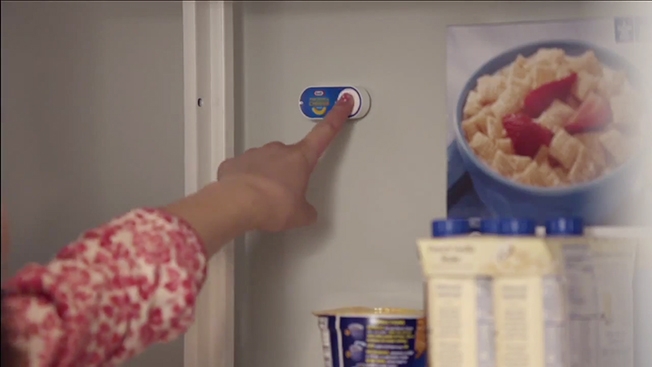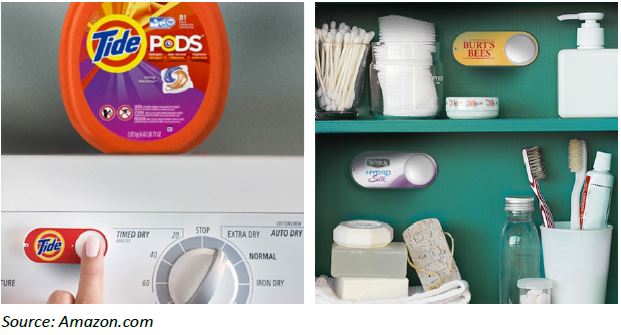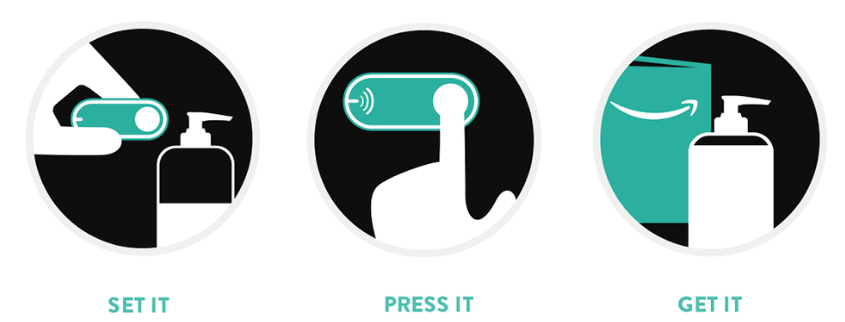Initially derided as an April Fool’s Day joke, Amazon’s Dash buttons have caught on with consumers who enjoy the convenience of reordering household items by simply pressing a button, rather than standing in line at a store or logging on to the Internet.
Originally, Amazon offered 10 different Dash buttons for everyday items such as laundry detergent, toilet paper, razor blades and diapers. Now, there are over 150 buttons for items ranging from pet food to guitar strings sold on Amazon; the Dash order rate recently doubled to more than two button presses per minute, or a run rate of more than a million orders a year. Amazon currently offers more than 150 Dash buttons in the categories listed in Figure 1.
 The buttons serve Amazon Prime members exclusively; adding value to membership as well as enticing non-members to sign up. This blog outlines why these buttons are only a portion of what Amazon’s Dash Replenishment Service (DRS) has to offer.
The buttons serve Amazon Prime members exclusively; adding value to membership as well as enticing non-members to sign up. This blog outlines why these buttons are only a portion of what Amazon’s Dash Replenishment Service (DRS) has to offer.
Operation
Using the Dash is very simple. It is a one-button product which is stuck to a surface with an adhesive strip. Each Dash button has the logo of the brand whose products are being ordered. It is configured via a smartphone app and connects to users’ Wi-Fi network in order to link to Amazon’s servers. When the button is pressed, the device’s LED illuminates and sends an order to Amazon to ship a predetermined quantity of product to the user’s address on file.
The goal is to remove the repetitiveness of refilling items such as coffee, ziploc bags and dish soap, as well as to save the user time and effort. In order to prevent accidental presses from placing multiple orders, once the button is pushed, it is disabled until the item is delivered. Users can also log on to Amazon and cancel an order before it is shipped.
During the setup process of each button, users can select from an array of products to order. For example, a press of the Tide button will place an order for one of the following 14 varieties of the detergent (Figure 2).

History
 The Dash button was released on March 31, 2015, and initially could only be used on an invitation-only basis. In July of 2015, it was released to Amazon Prime members. The device’s popularity increased tenfold in the first year and another 50% in the following three months.
The Dash button was released on March 31, 2015, and initially could only be used on an invitation-only basis. In July of 2015, it was released to Amazon Prime members. The device’s popularity increased tenfold in the first year and another 50% in the following three months.
Based on broker Piper Jaffray’s estimate of 300,000-500,000 Dash buttons shipped as of October 2015, Fung Global Retail & Technology estimates that at least 600,000 buttons have been sold to date. In August 2016, Amazon expanded the geographical availability of its buttons beyond the US to include the UK, Germany and Austria.

Source: adweek.com
Significance
Fung Global Retail & Technology considers Dash buttons significant for the following key reasons:
- The buttons are basically free: Each Amazon Dash button is US$4.99 and comes with a US$4.99 credit towards its first use, making the buttons free to consumers.
- The device offers convenience: Consumers no longer have to log onto Amazon.com or use their phone to order routine items. Once the Dash button is placed logically on the washing machine (or other household appliance, depending on the button) consumers will no longer forget to order detergent. This will allow them to save both time and effort, while at the same time, Amazon can receive orders more quickly.

- The device further cements the bond between Amazon and its customers: The service is designed to entrench consumers further into Amazon’s virtual loop; the more services it offers Prime members, the more likely they will renew their membership, which, in turn, makes them more likely to order from Amazon.
- The device can provide
 superior margins for Amazon: Members of Amazon Prime are known to want to “get their money’s worth” from their membership fees; meaning, members are not likely to search the web for cheaper deals for smaller savings. This leads to larger margins for Amazon. Figure 4 below shows Amazon’s margins in relation to the number of Prime members it has.
superior margins for Amazon: Members of Amazon Prime are known to want to “get their money’s worth” from their membership fees; meaning, members are not likely to search the web for cheaper deals for smaller savings. This leads to larger margins for Amazon. Figure 4 below shows Amazon’s margins in relation to the number of Prime members it has. - Dash is a technology platform that leverages the Internet of Things: While the most common use of the button is for replenishing household consumables, the button could be expanded to incorporate other sensors and output devices. It does, in fact, contain a processor, wireless communications, an output device (LED) and a sensor, which are the components of a portable wearable IoT device. It is a low-cost device to connect to the IoT and hackers have even reprogrammed the Dash button to perform additional tasks, such as order pizza, beer, Uber cars and control household electronic devices.
- The device represents another benefit exclusive to Prime members: It is an additional feature that Prime members have access to exclusively. Prime-only services include, free two-day shipping, media, such as video and music offerings, and Amazon Prime Now one- or two-hour shipping.
- It promotes Dash Replenishment Service (DRS): Dash Replenishment Service is Amazon’s infrastructure behind its Dash buttons and other connected devices that access Amazon’s retail platform to build automatic reordering experiences for its customers. Selected connected DRS devices include: Aesop Works’ iUSHU, Brita Infinity Smart Water Pitcher and GE appliances.
- The technology provides a source of data to Amazon: It is richly connected to Amazon’s commerce and replenishment system, and tracks time, frequency and location of all orders for each household. It provides another set of data to Amazon so it can optimize sales and profitability.

Source: amazon.com
It turns out Dash buttons are no joke. Rather, they are a simple, elegant Internet of Things (IoT) appliance that enables busy consumers to avoid the tedium of standing in line at a store or even having to pick up their smartphones to reorder everyday consumables. They are also an innovative demonstration of the benefits the IoT can bring to our everyday lives.
To learn more about Amazon Dash Buttons, read our full report here.
Reports you would find interesting: Amazon Vs. Top Us Retailers: Margins And International Sales, Identifying E-Commerce Winners: Our Ranking For Western Europe, Transforming Business Through Digital Manufacturing.
If you like what you are reading, subscribe for our daily news and analysis of retail, technology and fashion here. Connect with us on social media:
@DebWeinswig
@FungRetailTech
Facebook
LinkedIn
Subscribe to our YouTube channel
Pinterest
Instagram
